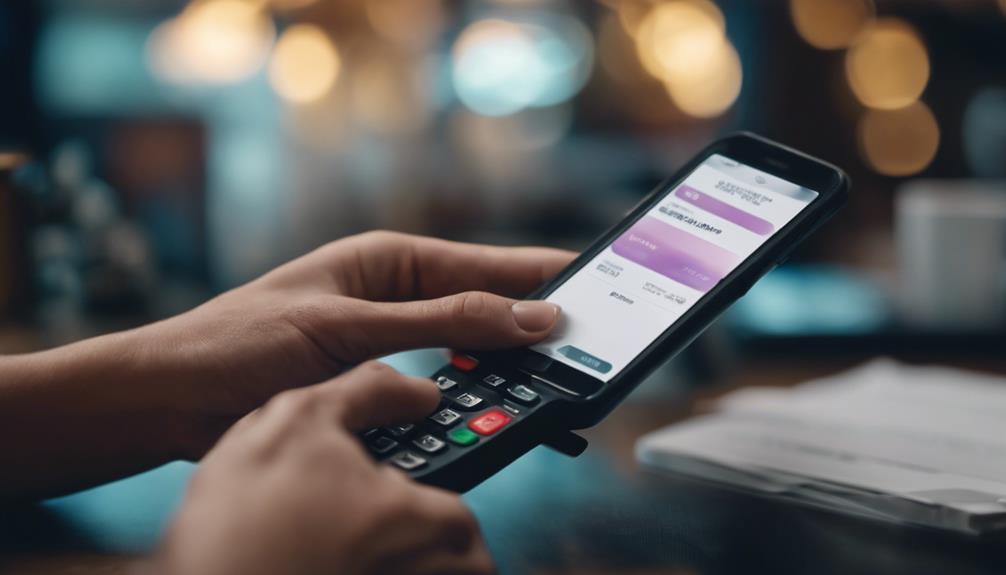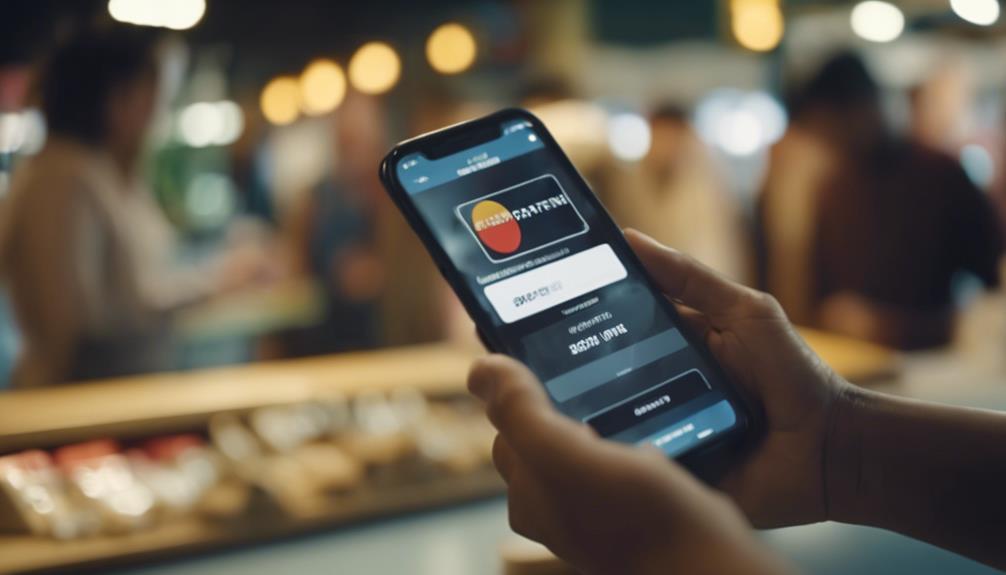The rise of mobile payment solutions has reshaped commerce by enhancing convenience and security. Technologies like NFC and mobile wallets streamline transactions, driven by smartphone adoption. Companies such as Apple and Google have revolutionized financial interactions. Shifts in consumer behavior, especially among Millennials and Gen Z, highlight the growing influence of mobile payments. Robust security measures, including encryption and biometrics, safeguard user information. This evolution has not only improved efficiency but also increased sales and customer satisfaction. Regulatory bodies guarantee adherence to standards, creating a safe environment. The impact of mobile payments continues to transform commerce greatly, offering unparalleled benefits.
Key Takeaways
- Mobile payment technologies revolutionized commerce with convenience and enhanced security.
- Shift towards mobile payments driven by speed, security, and convenience for Millennials and Gen Z.
- Security measures like encryption, tokenization, and biometrics ensure safe transactions.
- Mobile payments streamline transactions, increase sales, and reshape traditional commerce practices.
- Regulatory frameworks ensure compliance, standards, and safety in mobile payment operations.
Evolution of Mobile Payment Technologies

The evolution of mobile payment technologies has revolutionized commerce since the early 2000s, driven by the widespread adoption of smartphones. Mobile payment solutions such as NFC, QR codes, and mobile wallets have transformed the way we handle financial transactions. These technologies not only provide convenience but also enhance security, making payments easier and safer for users worldwide.
The adoption of mobile payment technologies has been remarkable, with platforms like Alipay, WeChat Pay, UPI, and Google Pay becoming essential in everyday transactions. Companies like Apple, Google, and Samsung have been instrumental in shaping the landscape of mobile payments by introducing innovative features and services that cater to the growing demand for seamless financial interactions.
In the domain of e-commerce, the integration of mobile payments has significantly impacted the sector. Online retailers now benefit from simplified checkout processes, leading to increased sales and improved customer satisfaction. As technology continues to advance, the future of mobile payments looks promising, offering a more streamlined and efficient way to conduct financial transactions.
Consumer Behavior Shifts Towards Mobile Payments

With the surge in global smartphone usage, consumers are increasingly gravitating towards mobile payments for their transactional needs. This shift in consumer behavior towards mobile payments is driven by several key factors:
- Convenience: Mobile wallets offer users the convenience of making payments anytime and anywhere, eliminating the need to carry physical cash or cards.
- Speed: The quick and seamless nature of mobile payments appeals to users who value efficiency in their transactions, making the process faster than traditional payment methods.
- Security: The emphasis on security in mobile payment solutions reassures consumers about the safety of their financial information, ultimately boosting trust in e-commerce platforms.
This change in consumer behavior is particularly noticeable among Millennials and Gen Z, who are at the forefront of adopting mobile wallets for their online transactions. As more transactions are completed via mobile devices, the influence of mobile payments on commerce continues to grow significantly.
Security Measures in Mobile Payment Solutions

Security measures in mobile payment solutions employ advanced encryption and tokenization techniques to safeguard sensitive user information during transactions. Encryption scrambles data to make it unreadable to unauthorized parties, while tokenization replaces sensitive data with unique tokens. Additionally, various authentication methods, including biometrics and PINs, help verify users' identities, ensuring secure transactions. Fraud detection systems play a crucial role in monitoring activities and preventing unauthorized access. Strong passwords and PINs are essential for maintaining account security and preventing potential breaches. These security measures create a safe environment for users to conduct transactions without compromising their financial information. By implementing robust security protocols, mobile payment solutions strive to offer users peace of mind and confidence in their financial transactions.
| Security Measure | Description | Importance |
|---|---|---|
| Encryption | Protects sensitive data by encoding it to prevent unauthorized access | High |
| Tokenization | Substitutes sensitive information with unique tokens to enhance security | Medium |
| Authentication Methods | Various techniques such as biometrics and PINs used to verify user identities | High |
| Fraud Detection | Systems that monitor transactions for suspicious activities to prevent fraud | High |
Impact on Traditional Commerce Practices

As mobile payment solutions continue to advance security measures, they're revolutionizing traditional commerce practices by enhancing efficiency and convenience. Businesses are increasingly integrating mobile payments into their operations, leading to the following impacts on traditional commerce practices:
- Eliminating the Need for Traditional Payment Methods: Mobile payments are streamlining transactions and reducing the reliance on cash and traditional payment methods.
- Increased Sales and Customer Satisfaction: Businesses that have embraced mobile payment solutions are witnessing increased sales and higher levels of customer satisfaction.
- Reshaping the Commerce Landscape: The integration of mobile payments is reshaping the way businesses and consumers interact in the commerce landscape, marking a shift towards a more efficient and convenient mode of transaction.
The enhanced security features offered by mobile payments have also played an important role in driving this transformation, making transactions more secure and reliable than traditional methods. Despite initial resistance to change, the convenience and efficiency brought about by mobile payment solutions are gradually winning over businesses and consumers alike.
Regulatory Framework for Mobile Payments

How do regulatory frameworks impact the implementation and operation of mobile payment solutions?
The regulatory framework for mobile payments sets guidelines and laws that govern the use of mobile payment solutions, ensuring compliance with regulations for security, consumer protection, and financial stability in mobile transactions.
Regulatory bodies, such as the Central Bank, play an important role in overseeing mobile payment operations to mitigate risks and prevent fraud.
These regulations aim to create a safe environment for mobile payment users by establishing standards that must be followed by industry participants.
The variations in regulations across countries can impact the adoption and development of mobile payment technologies globally.
Frequently Asked Questions
How Important Is Mobile Payments to Businesses Today?
Mobile payments are immensely important to businesses today. They provide convenience and security, leading to increased sales and customer satisfaction. Businesses benefit from seamless checkout experiences, reducing purchasing friction.
What Are the Benefits of Mobile Payment System?
Mobile payment systems offer convenience with the ability to make transactions using your smartphone. Enhanced security features like encryption and authentication protect your sensitive information.
Streamlining the checkout process, businesses benefit from quicker transactions. Integrated loyalty programs and digital receipts enhance the user experience.
Younger generations are increasingly adopting mobile payment solutions due to their ease of use and convenience.
How Does Mobile Payment Technology Affect Consumer Payment Behavior?
When you use mobile payment technology, your payment behavior changes due to its convenience and accessibility. With just a smartphone, you can make quick and secure transactions, eliminating the need for physical cards.
Digital wallets like Apple Pay and Google Pay simplify payment management, while peer-to-peer platforms such as PayPal and Venmo allow easy money transfers on-the-go.
This shift towards mobile payments encourages impulsive purchases and boosts sales by catering to your on-the-spot payment needs.
What Are the Factors Influencing the Adoption of Mobile Payments?
When considering the factors influencing the adoption of mobile payments, it's crucial to recognize the significant role of convenience, security, and technological advancements.
The ease of making quick transactions, coupled with the trust instilled by enhanced security measures, drives consumers to embrace mobile payment solutions.
Additionally, the widespread availability of smartphones and the growing preference for cashless transactions contribute to the increasing adoption of mobile payments in the commerce landscape.
Conclusion
To sum up, the rise of mobile payment solutions has revolutionized the way we conduct transactions. With increased convenience and security measures in place, consumers are shifting towards mobile payments at a rapid pace. This shift is impacting traditional commerce practices, driving the need for businesses to adapt to the changing landscape. As more and more consumers rely on mobile payment solutions, businesses must integrate these options into their sales strategies to remain competitive. Additionally, the versatility of mobile payment solutions allows for a wider reach and access to a broader customer base. Overall, the widespread adoption of mobile payment solutions is reshaping the way we engage in financial transactions and is poised to continue transforming the business world.
As regulations continue to evolve to accommodate these advancements, mobile payments are here to stay and are shaping the future of commerce. So, embrace the change and hop on the mobile payment bandwagon!










